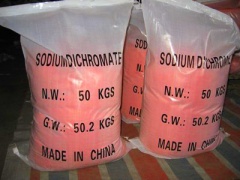Sodium dichromate
| Infobox on Sodium dichromate | |
|---|---|
| Example of Sodium dichromate |  |
| Facts | |
| Origin | - |
| Stowage factor (in m3/t) | - |
| Humidity / moisture | - |
| Ventilation | - |
| Risk factors | See text |
Sodium dichromate
Contents
Description
Sodium dichromate is the chemical compound with the formula Na2Cr2O7. Usually, however, the salt is handled as its dihydrate Na2Cr2O7•2H2O. Virtually all chromium ore is processed via conversion to sodium dichromate. In this way, many millions of kilograms of sodium dichromate are produced annually. In terms of reactivity and appearance, sodium dichromate and potassium dichromate are very similar. The sodium salt is, however, around twenty times more soluble in water than the potassium salt (49 g/L at 0 °C) and its equivalent weight is also lower, which is often desirable.
Sodium dichromate is generated on a large scale from ores containing chromium oxides. The ore is fused with a base, typically sodium carbonate, at around 1000 °C in the presence of air (source of oxygen). This step solubilizes the chromium and allows it to be extracted into hot water. At this stage, other components of the ore such as aluminium and iron compounds, are poorly soluble. Acidification of the resulting aqueous extract with sulfuric acid or carbon dioxide affords the dichromate, which is isolated at the dihydrate by crystallization. Since chromium is toxic, especially as the dust, such factories are subject to stringent regulations. For example, effluent from such refineries is treated with reducing agents to return any chromium to chromium, which is less threatening to the environment.
Sodium dichromate comprises red or red-orange deliquescent crystals, It is soluble in water and insoluble in alcohol.
Application
Dichromates are power oxidizing agents which find applications in: Chromium source in preparing chromium compounds, Leather tanning and screen printing, Electroplating ,Pyrotechnics and explosives, Pigment preparation, Wood Preservative , Metal Treating and corrosion inhibitor, Oil drilling ,Catalyst for the chromium metal production ,Photographic engraving.
In the pigment industry, sodium dichromate is used to manufacture lead chromate compounds which are then used in manufacturing paints, printing inks, paper coloring, and floor coverings.
In oil well drilling muds, sodium dichromate is used to create soluble chromates for corrosion control and chrome lignosulfates for deflocculation and thinning agents which help control drilling mud viscosity. Sodium dichromate is also used in the manufacture of photographic films, flavours, essential oils, saccharin, pharmaceuticals,9 pyrotechnics, explosives, safety matches, chrome glues and adhesives, wood stains, poison fly paper, process engraving and lithography, synthetic perfumes, chrome alum manufacture, alloys, ceramic products, depolarizers in dry cell batteries, bleaching fats and waxes. Consumption of chromium chemicals has been in decline since peaking at 163 thousand tons in 1974. This is primarily due to environmental and health concerns. The trend has apparently now ceased and the current consumption level represents difficult-to-substitute applications of chrome chemicals. Over the next four years, U.S. sodium bichromate consumption is anticipated to grow modestly, at 0.5 percent annually.
Shipment / Storage
Sodium dichromate is shipped in multi-ply paper bags or fibre drums. When exposed to the air over an extended period will become a semi-solid pliable mass and change colour to brilliant red. Will liquefy when exposed to heat. Only handle with suitable protective clothing. It is a toxic material.
Boiling point: 400° C
Melting point: 357° C
Risk factors
Like all hexavalent chromium compounds, sodium dichromate is considered hazardous. It is also a known carcinogen.
Consult the applicable MSDS sheet for safe handling advice.











